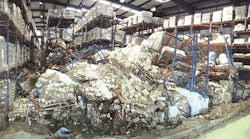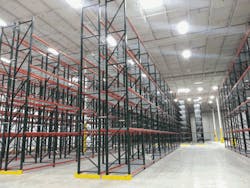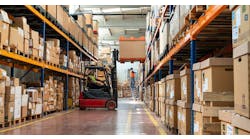A video posted on YouTube has done wonders for Thomas Gibbs's business as a safety consultant. Gibbs' company is United Rack Services (www.racksurvey.com), and his job is to do safety inspections. Normally, forklifts hog all the attention when it comes to safety. Poorly operated, they are among the top causes of death and destruction in a warehouse or distribution center. But they often have a partner in crime and it took a viral video of a rack collapse in a Russian vodka warehouse to demonstrate the mayhem this team can cause.
The video shows a forklift operator driving in reverse down the aisle of this warehouse, surrounded on all sides by racks filled to the brim with cases of vodka. All of a sudden, the operator makes a sudden turn and backs into a support beam. The viewer then witnesses a disastrous game of dominos. One by one, rack after rack of product crashes down on top of this driver and everything else that was around him. The footage concludes with fellow warehouse workers frantically trying to dig him out.
This poor operator, and obviously the manager of this facility, never gave much thought to inspecting the integrity of their pallet rack.
But as Gibbs points out, not even OSHA addresses rack safety specifically. OSHA's approach can be seen in their "Material Handling and Storage" guidelines (www.osha.gov/Publications/osha2236.pdf), which answers the question, "What precautions must workers take to avoid storage hazards?" Their answer: "Storage of material shall not present a hazard to employees." Other than that, and the admonition that workers should "consider placing bound material on racks, and secure it by stacking, blocking, or interlocking to prevent it from sliding, falling, or collapsing," rack hazard prevention is left up to the user.
The Cost of Collapse
Gibbs says that if you do have a rack collapse it will cost you much more than what it would have cost to remedy the situation before something like a collapse happens. Even if an employee doesn't get injured in a rack collapse, someone still has to replace the product that was lost, and because everybody is running JIT right now, if those products happen to be components in an assembly, they won't be available when they're called for on the assembly line. That will cost the manufacturer of that product serious money, Gibbs explains. Ironically, he believes that because racking is generally less substantial in Europe than in the U.S., there's greater consciousness of the kinds of collapses that can occur—thus rack safety inspections are now mandatory there. In fact Gibbs uses the European standard in his practice.
"I think the rack in Europe is made more flimsy than what we have, and their ministries of labor are a lot more intrusive into their day-to-day operations than OSHA is," he says. "That's why they passed a law saying you must have your racking inspected, either by the manufacturer or some other qualified person."
The Cause of Collapse
Considering the fact that forklift operators are constantly negotiating tight turns into and out of aisles, occasional accidental contact with uprights is inevitable. But another issue that's not so obvious is the number of times that rack may be reconfigured to accommodate new products or material handling scenarios. Gibbs offers an example:
"Ten years down the line, say somebody decides their storage needs have changed, and instead of having the first beam at 48 inches maybe they move it to 66 inches. That can drastically weaken the structure. That's why buying used rack is a real problem. And consider, if your company buys another company and you inherit the rack from somebody else, you're inheriting somebody else's problems as well."
Jeff Ross, vice president of consulting for Forte (FORTE-Industries.com), says he's seen that issue come up a lot in his company's consulting practice.
"If I'm moving out of a facility the cost to tear down the pallet rack and move it is sometimes close to the price of buying new rack and having it installed," he says. "Not only do I have to tear down and reinstall, but there's also the transportation cost of the equipment relocation. Buying new, it's a one-time transport and install. So if the rack is left in the building, the new tenant will want to leverage that rack if they can. That's why we always suggest considering if the nature of the product has changed substantially, whether it's heavier or lighter. Don't assume that because the rack is still standing that everything is fine, even if it looks great."
Tips to Avoid Collapse
Whether you're inspecting rack that you're inheriAting or just looking at the rack you've been using for years, Gibbs suggests you look at the entire structure up and down, not just the base. And, standing at the head of an aisle, look down the entire length at the outside frames of the columns. If you see any leaning in, that should be a red flag.
Then walk down the aisle and check for damage to any of the components, and see if any of the safety locks are missing from the beams.
How often should you be doing this? There's no official recommendation as of yet, although the Rack Manufacturers Institute (www.mhi.org/rmi) will soon be releasing a Rack Repair Guideline on the "How" and "Why" to handle damaged rack in warehouse and distribution center environments. But because rack damage is not always readily apparent, it's best to make periodic inspections. How frequent is up to you, but it should be based on educated assumptions. David Hoover, president of Forklift Training Systems (www.forklifttrainingsystem.com), suggests making it part of other safety inspections you are required to make.
"There's no reason the people looking at other things like fire extinguishers couldn't be cross trained to look at racking as well," he says, "and if we do it periodically and we've created an environment where the operators can come and tell us when they have damage, then we'll go a long way to fixing things on a timely basis."
Most racks don't fail spectacularly in one Youtube moment. Damage is most often incremental and can be diagnosed before the prognosis becomes dire.




